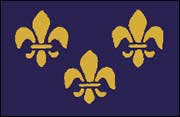
During the sixteenth century, France was determined to expand its empire. Spain, the world’s leading power, already had a foothold in the Americas, and France wanted a share of the riches the Spanish were gaining through trade, plunder, and the exploitation of indigenous lands. France’s first attempt to stake a permanent claim in North America was at La Caroline, a settlement near the mouth of the St. Johns River in Florida. At first, the settlement was to be a commercial venture, but religious conflict in France broadened the goals. The growing persecution of French Protestants (Huguenots) led their most powerful member, Admiral Gaspard de Coligny, to make a proposal to the crown: the colony could also be a refuge for Huguenots. An exploratory expedition, commanded by Jean Ribault, left France in February 1562. On this voyage, they erected a monument at the River of May (now known as the St. Johns River). Permanent settlement of 200 soldiers and artisans began in 1564, led by Rene de Goulaine de Laudonniere, who had accompanied Ribault on the previous expedition. With help from the Timucua-speaking Mocama people, the colonists began building a village and fort on the river’s south bank, naming the area La Caroline after their king, Charles IX.
|
Last updated: March 14, 2024
